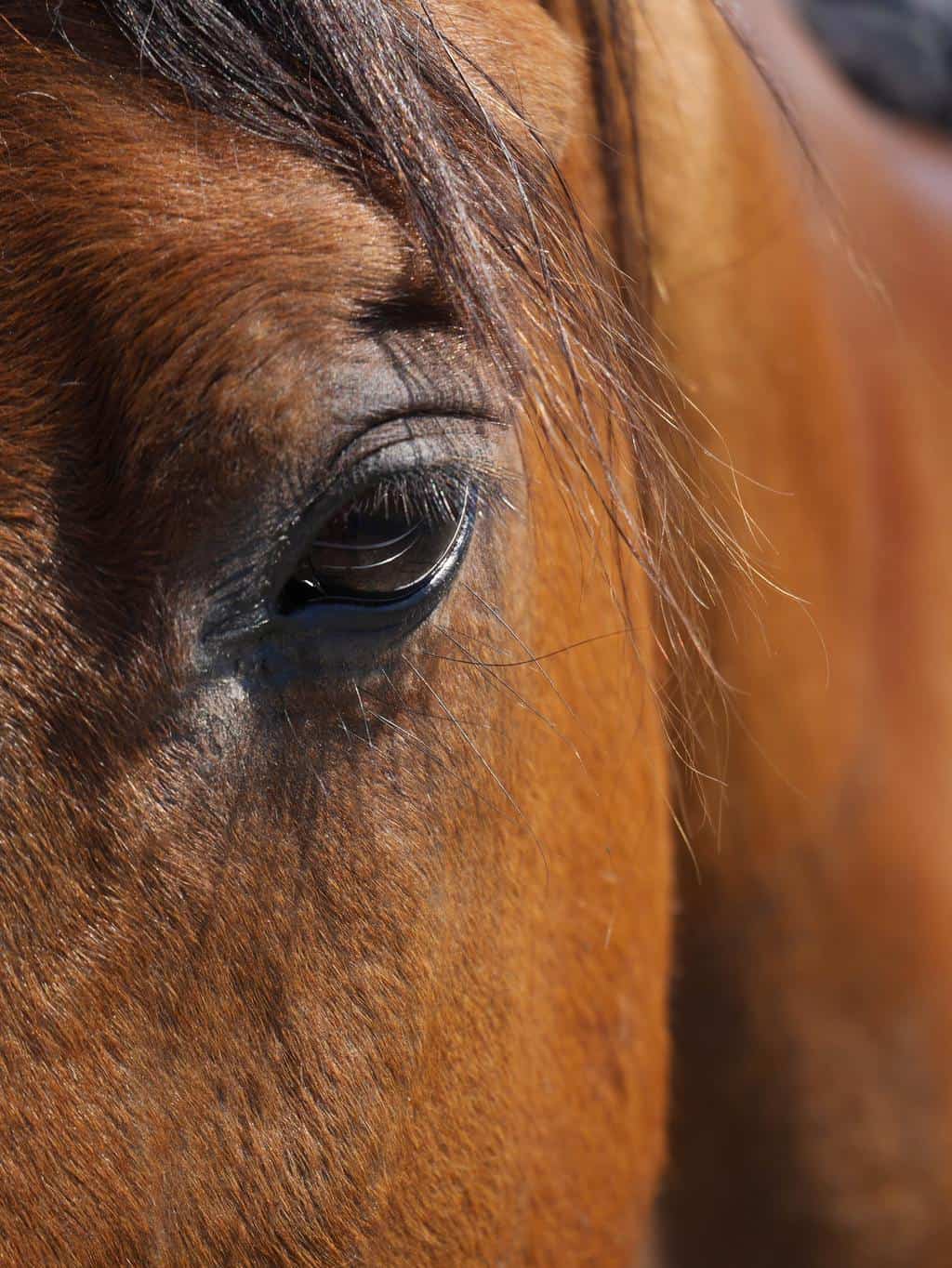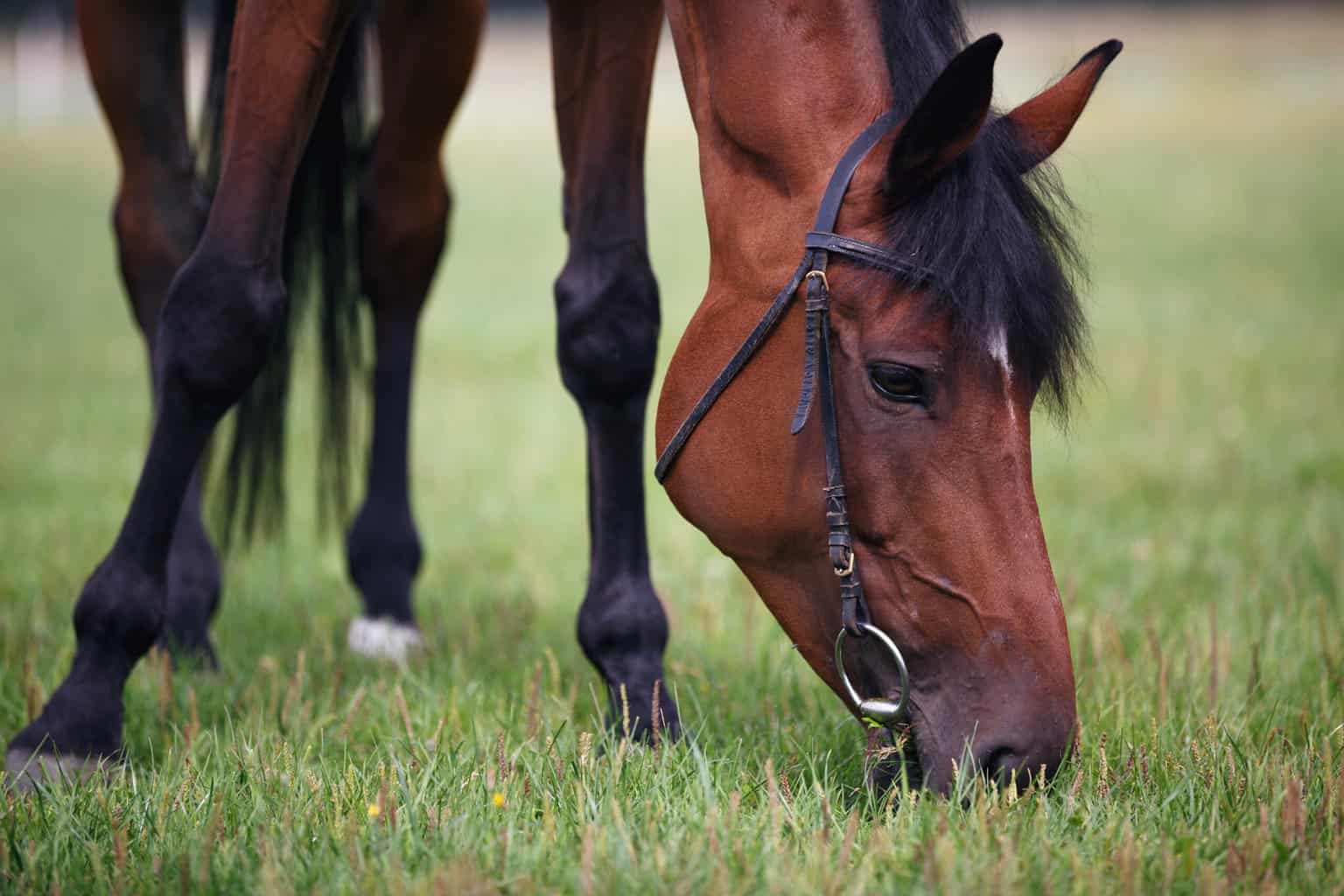- Best Antibiotics for Horse Wounds: What to Expect When Your Horse Has an Injury - September 20, 2023
- Bronco vs Mustang Horse: Are They the Same? - September 8, 2023
- Thoroughbred vs Quarter Horse - September 8, 2023
Bay horses have been around for some 42,000 years, yet they’re often mistaken for other horses today. Could you confidently identify a bay horse? It can be harder than you may think! Trust me, I know! If I had a dollar for the number of times, people have asked me.
In this guide, you will find out everything you could possibly want to know about this horse, including how to spot one and the colors that define a bay horse.
What Is a Bay Horse?
Genetically, the bay coloring occurs when a horse carries both the Agouti gene and a black base coat.
Bay is one of the most common coat colors in many horse breeds yet will never be found in others. It refers to the hair coat color of horses, characterized by a brown or reddish-brown body color with a black point coloration of the lower legs, ear edges, tail, and mane.
Although bay is a prevalent color, I find it one of the most beautiful and versatile. As a girl watching horse racing and attending horse fairs, bay was always a color I’d see in copious amounts. Perhaps my love for this horse is purely nostalgic. Or, perhaps, it’s because they’re truly beautiful creatures.
In my experience, bay horses are energetic, intelligent, and loyal animals. But, of course, bay is a color and not a breed, so this may not always run across the board.
Bay Horse Quick Facts
| Species | Horse |
| Horse Family | Equidae |
| Horse Breed | Cleveland Bay, Yorkshire Coach Horse, Irish Sport Horse, Clydesdale Horse, Holsteiner, Thoroughbred, Quarter Horse, Tennessee Walking Horse, Arabian Horse, Andalusian Horse. |
| Common Names |
|
| Country of Origin | Most Countries |
Bay Horse Overview
Bay horses are found in many breeds, and this is one of the most common coat colors there is. The genetic makeup of bay horses is complex and disputed, with some studies still occurring today.
Because bay horses can be found in many horse breeds, this means that you have no idea of the horse you’ll end up with if you’re choosing on color alone. However, there will always be a specific genetic combination for a bay horse, either EEAa, EeAA, or EeAa. And this can give you more of an understanding of the possible temperament and trainability.
You will have undoubtedly met or seen a bay horse in your time. From the racing tracks to the silver screen – and even many record-breaking bays – these horses are simply everywhere. Yet, identifying them isn’t always easy.
How to Identify a Bay Horse
Not all horses with brown or reddish-brown coats will be brays. A true bray horse will feature black areas of the coat – known as ‘black points’ – and if these aren’t apparent, then the horse isn’t a bray. These black points can be covered with white markings, making the identification more challenging.
Under any white markings on a bray, horse will be pink skin, but under the darker colors, the skin will be very dark.
Colors That Define a Bay Horse
Bay is the product of both the allegele and agouti genes. When there is an additional equine gene acting on a template of bay, this will change the fundamental pattern, resulting in various shades.
Here are the most common colors of bay horses:
- Perlino Horses: These horses have a combination of black and red pigment, which results in a diluted creme shade. Perlino horses have slightly pinkish skin and blue eyes.
- Amber Champagne Horses: These horses will have a single dominant champagne allele, at least. This results in a dilution of black and red pigments to form a golden, brownish color. Amber Champagne horses will have chocolate points and hazel-colored eyes.
- Bay Roan Horses: Bay roan horses are also known as red roan horses and have a dominant roan gene that consists of a mixture of red and white coloring. An interesting fact about bay roans is that if the horse receives a cut or scrape, the hair will always grow back black, which can result in a pretty distinctive pattern!
- Bay Leopard Horses: These horses are extremely rare but stunning nonetheless. Bay Leopard horses possess a specific Lp leopard pattern that leads to dramatic characteristics like a striking white patch around the eyes, mottled skin, and even striped hooves.
- Buckskin Horses: Buckskin horses have a dominant allele creme and are characterized by their cream or golden coat and black tail, mane, and lower legs.
- Bay Dun Horses: Bay Duns are identified by a dark stripe that runs down the center of the mane, back, and tail. Like the bay leopard, these horses can have stripes on their legs and other unique markings.
Bay Horse Lifespan
Bay is a coloring present in many breeds, so there isn’t a definitive lifespan for a bray horse. Still, typically, domestic horses will leave between 25 and 30 years. These days, horses live longer, and healthier lives as their care (and the education around it) continues to improve.
Horse care isn’t easy. It requires a lot of commitment and dedication. Even on those real frosty, skin-biting days, that horse still needs to drink around 10 gallons of freshwater, be fed a balanced diet, and have its coat brushed. Additionally, teeth and hooves are best checked daily for any signs of damage, injury, or infection.
Horses need regular veterinary care and vaccinations, as well as routine worming. And all this is before we look at mental stimulation and physical exercise! But, if looked after properly, your horse stands the best chance of having a long and happy life.
There are many cases of domestic horses living well into their 30’s, 40’s, and even 50’s, with the world’s oldest horse (Old Billy) being 62-years young when he passed on!
Bay Horse Appearance and Varieties
Bay horses can look widely different due to the various breeds this coloring is found in. Bay horses have two standard features: black ‘points’ and dark skin. However, the coloring of the coat doesn’t change and will always be brown or red-brown.
Bay horses are found in many breeds, but most notably:
- Cleveland Bay
- Yorkshire Coach Horse
- Irish Sport Horse
- Clydesdale Horse
- Holsteiner
- Thoroughbred
- Quarter Horse
- Tennessee Walking Horse
- Arabian Horse
- Andalusian Horse
Bay Horse Human Interactions and Training

Draft horses and racing horses will often be bay, and this coloring tends to be found in many powerful and active breeds. This means that an experienced handler would be best suited to a bay horse. Bay horses can be extremely intelligent and super-fast learners, which is why they’re so often used as working horses.
Like all horses, bays need a good amount of exercise and training (rope halters are a great go-to) for them to remain mentally and physically well.
Bay Horse Diet
Horses are natural grazers, and grasses (with its high roughage content) will make up most of their diet. However, if you’re traveling with your horse or there isn’t free access to grass in your location, you can provide a fiber-based diet with haylage or hay replacement to mimic their natural feeding.
Bay horses need to be fed a diet that reflects their needs, with consideration given to their breed, age, weight, condition, health, and level of activity.
Vegetables, fruits, concentrates, and salt can enhance their diet.
Bay Horse Cost
Because bay horses are found in so many breeds, there isn’t an exact price point. You may find a bay horse for a few hundred dollars. Still, you could have to part with a substantial amount of money as this coloring runs in some really expensive breeds like the Thoroughbred.
In the year 2000, a Thoroughbred named Fusaichi Pegasus sold for $70 million at auction and is said to be the most expensive horse in history.
Where to Buy a Bay Horse
Today, it couldn’t be easier to purchase a new stallion or mare. Gone are the days when you’d have to travel to horse shows and auctions; now, you merely have to go online. While it’s never advisable to buy a bay horse without seeing it first, online horse marketplaces can give you a great idea of what’s available in your area, your budget and that meets your criteria.
Here’s a shortlist of my favorite horse buying websites:
Equine Now
My favorite thing about Equinenow is its usability. Not everyone is great with these sites, but this one couldn’t be simpler. You can filter your horse search by state and price range and look for listings that meet your criteria: horse age, height, color, skill set, and breed.
Exchange Hunter Jumper
A significant advantage of using Exchange Hunter Jumper is that the site vets every single listing to ensure authenticity before that ad goes live. This process means that you’re at much less of a risk of being conned.
Equine
I like the search bar feature at Equine that allows you to search using specific keywords – such as Bay horse. This is a nationwide marketplace that shows available horses from all over the US.
Horse Plus Humane Society
If you’re considering rehoming a horse, there are many benefits of doing this through agencies like the Horse Plus Humane Society. Any future risks are greatly reduced as these horses undergo full veterinarian and training evaluations to ensure they’re rehoming. New owners will also receive full disclosures of any behavior problems.
Famous Bay Horses
Check out the following famous bay horses for a greater appreciation of what this horse is truly capable of!
- Seabiscuit: Voted Horse of the Year in 1938. Seabiscuit was a light bay champion racehorse who rose to fame when he beat triple crown winner War Admiral in a race.
- Northern Dancer: Known as ‘the most successful sire of the 20th century,’ people would pay up to $500,000 for his studding services. Of 645 named foals from standard bay Northern Dancer, 411 were race winners.
- Cigar: This 1996 American Horse of the Year Winner had a distinguished racing career, winning 16 consecutive competitions. The dark bay horse became the leading money earner in racing history and has been inducted into the Racing Hall of Fame.
FAQs
Answer: Although bay horses are found in an incredible number of breeds, there are some breeds that will never have a bay horse in their catalog. These will be purebred horses that don’t ever mix with bay genes. These breeds include Friesian Horse, Suffolk Punch, and the Hafflinger.
Answer: Bay horses are dark brownish-red, except for their mane, muzzle, legs, ear tips, and tail, which will be black. Brown horses tend to have one color all over the body, with no black points.
Question: What are the Most Common Horse Coat Colors?










